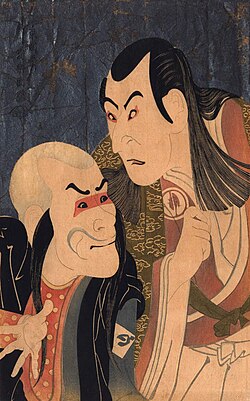
Back Yakusha-e Catalan Yakusha-e Spanish Yakusha-e Finnish Yakusha-e French Yakusha-e ID 役者絵 Japanese Yakusha-e Portuguese Якуся-э Russian Yakusha-e SIMPLE Yakusha-e Vietnamese


Yakusha-e (役者絵), often referred to as "actor prints" in English, are Japanese woodblock prints or, rarely, paintings, of kabuki actors, particularly those done in the ukiyo-e style popular through the Edo period (1603–1867) and into the beginnings of the 20th century. Most strictly, the term yakusha-e refers solely to portraits of individual artists (or sometimes pairs, as seen in this work by Sharaku). However, prints of kabuki scenes and of other elements of the world of the theater are very closely related, and were more often than not produced and sold alongside portraits.
Ukiyo-e images were almost exclusively images of urban life; the vast majority that were not landscapes were devoted to depicting courtesans, sumo, or kabuki.
Realistic detail, inscriptions, the availability of playbills from the period, and a number of other resources have allowed many prints to be analyzed and identified in great detail. Scholars have been able to identify the subjects of many prints down to not only the play, roles, and actors portrayed, but often the theater, year, month, and even day of the month.